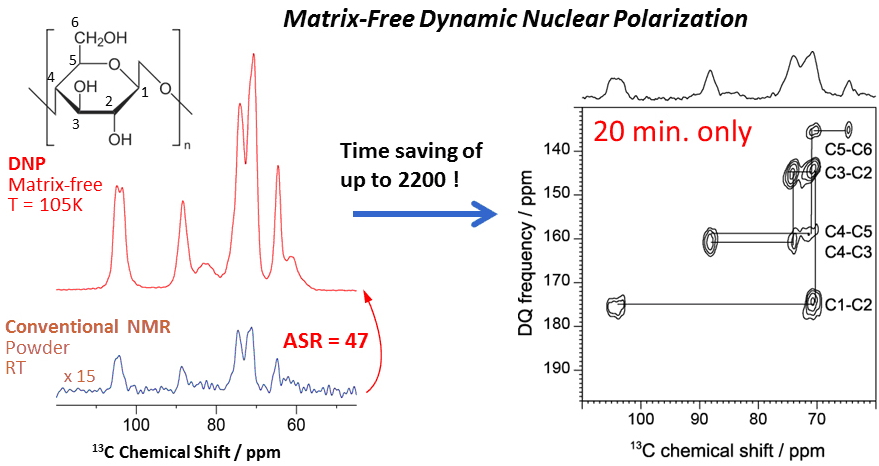Structural studies on organic systems using solid-state NMR are commonly performed on
13C and/or
15N enriched samples in order to compensate for their low natural abundance (1.11 % for
13C and 0.37 % for
15N). However, this strategy is mainly restricted to biomolecules that can be easily isotopically enriched and has proven difficult to expand to other types of systems. To date, only a few examples of natural-abundance 2D
13C–13C correlation experiments in solids have been reported and these types of experiments are limited to small crystalline molecules since it already requires 2 to 10 days of experimental time due to the low sensitivity and low abundance of
13C nuclei.
Recently, DNP performed with a high-power high-frequency microwave source (gyrotron), a low temperature (~100 K) magic-angle spinning (MAS) probe and a suitable polarizing agent has emerged as an appropriate answer to the sensitivity limitation of solid-state NMR. We have combined DNP and introduced a new sample preparation technique, dubbed the matrix-free (MF) method, in order to perform natural-abundance 2D
13C–13C correlation spectra in a time equivalent to that needed for isotopically labelled systems.
The MF method uses a binding affinity of a polarizing agent to the sample of interest in order to distribute the polarizing-agent molecules uniformly in the sample without using solvents and cryoprotectants. This technique avoids the problems that DNP-enhanced solid-state NMR usually faces, such as line-broadening, sample dilution and signal overlaps with cryoprotectants. Applying MF-DNP to natural-abundance microcrystalline cellulose, a ‘real’ sensitivity enhancement of 47 was observed when compared to conventional solid-state NMR, which corresponds to a time-saving of 2,200. Thanks to this high sensitivity, a 2D
13C–13C correlation spectrum on this natural abundance sample could be recorded in only 20 minutes as shown in the figure. This opens new perspectives for the structural determination of organic and bio-molecules without the need of isotope labelling.
Further investigations are in progress in the laboratory to extend MF-DNP to other types of samples such as materials and biomolecules. Thus, MF-DNP will become a standard technique for DNP-enhanced NMR.
